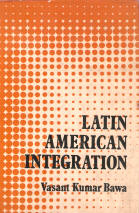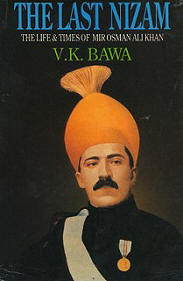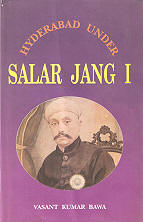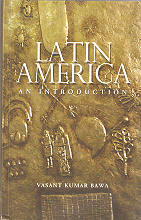|
LATIN AMERICAN
INTEGRATION Radiant
Publishers, 1980. Reprinted
by Humanities Press, Atlantic Highlands, New Jersey, 1981.
Copyright Dr. Vasant
Kumar Bawa
 |
The book critically examines the
emergence and growth of Latin American integration and analyses the
motivations behind the integration movement against the background of
the internal policy of the
major countries of Latin America, the
political ideologies of the times, and the policies and
role of the United States of America.
It discusses the ideas of
Raul Prebisch, assesses his contribution to the integration process, and
points to some of the defects in the integration model such as the
failure to stress sub-regional integration, and over-reliance on the
Western European
integration model.
|
The study focuses attention on the
evolution of a functional approach to the problems of the region, the
efforts to develop infrastructure and mobilize regional resources, and
the relevance of these efforts for Asian and the Third World.
Based on library research and on personal
interviews with officials who played a leading role in the process of
Latin American integration, this study is important for students of
Latin American Studies, American foreign policy, international economics
and international politics.
THE
NIZAM BETWEEN MUGHALS AND BRITISH – Hyderabad under Salar Jang I
[S. CHAND & COMPANY LTD, Ram Nagar, New Delhi 110055, 1986.
[Second edition, 1996.] Copyright
Dr. Vasant Kumar Bawa]
|
This book examines a crucial figures in
the history of the Nizam’s Dominions which was originally a vice
royalty of the Mughal Empire but accepted the suzerainty of the British
Raj.
Salar Jung-I was appointed Diwan of the
Nizam of Hyderabad in 1853, when he was only 24 years of age. The
Hyderabad State had just lost to the British the rich province of Berur,
and Salar Jung’s family fortunes were at a low ebb. The Nizam and
Salar Jung supported the British during the revolt of 1857 although the
Nizams had always, till then, been loyal to the British Emperor. This
was the first modern study of Salar
Jang I, who had not been the subject of a full-scale biography in spite
of his important role as an
administrator and modernizer of Hyderabad as well as a major statesman
of 19th Century India.
|
 |
INDIAN METROPOLIS
–
Urbanization Planning and Management [Inter-India
Publications, D-17, Raja Garden Extn., New Delhi 110015, 1987.] ISBN
81-210-0183-8. [Copyright Dr.
Vasant Kumar Bawa]
The author was a Secretary to the Andhra
Pradesh Government, dealing with problems of urban development form
1973-4, and the first
Vice-Chairman and Chief Executive of the Hyderabad Urban Development
Authority from 1974-79. Later,
he carefully studied the problems of the three cities of Bombay, Pune
and Hyderabad as a Senior Fellow of the Indian Council of Social Science
Research at the Gokhale Institute of Politics and Economics, Pune and
Indian Institute of Management, Bangalore.
The book focuses
attention on the problem of
rapidly-growing cities of India. It takes
up as case-studies the major cities of Bombay [now Mumbai), Pune
and Hyderabad. The problems of these cities is not insuperable. The
writer identified some specific
problem areas, which he
examined in regard to these cities.
Among these problems are the
breakdown of transportation and water supply systems,
the burgeoning
growth of slums, and the failure of infrastructural facilities.
The book combines an
academic understanding with a pragmatic approach to the problems of the
Indian Metropolis. It is written by an administrator with field
experience of metropolitan planning, both for practitioners and for
those concerned with the academic study of the city, in fields like
Geography, Economics, Public Administration, Engineering, Town Planning,
Sociology and Politics.
THE LAST NIZAM : The Life and Times of
Mir Osman Ali Khan [Viking
Penguin India ] ISBN 0-670-83997-3,
Hard cover.1992 and Paperback,1993.]
Copyright Dr. Vasant Kumar Bawa

This is a biographical study of Mir Osman
Ali Khan who ruled the state of Hyderabad, also known as the Nizam’s
Dominion from 1911 till 1948 when his autocratic ended. From 1950 till
1956 he served as Rajpramukh or constitutional head of the state. He
continued to enjoy the title of Nizam till his death in 1967.
The book is also a history of the
state during the long reign of its last effective ruler. The historian
Parthasarthy Gupta described the book as “the best short introduction
to the history of a region which straddled three linguistic groups -
Telugu, Marathi, and Kannada and whose separate political
existence under the Asaf Jahi dynasty… lasted two centuries… The
professional historian will be particularly grateful for the very
illuminating critical note on sources that appear on pp 348-66.”
Mir Osman Ali Khan dreamt
of being independent after the British left India. He also
refused to transfer power to the people or even introduce consultative
bodies till it was too late. The suppression of the popular movement for
self-government under the Nizam’s aegis, was bound to lead to a demand
for integration in the rest of India, as it gained independence. The
rise of national feeling in India as a whole could not leave Hyderabad
state untouched. The peasantry of Telengana were deeply dissatisfied
with conditions in the Nizam’s Dominions, and
the agrarian revolt may have played a major role in the
Government of India’s decision to intervene militarily in 1948.
The book starts with a chapter on
the dynasty of the Nizam’s of
Hyderabad, descended from a Subedar or Viceroy appointed by the Mughals
not long after the death of Emperor Aurangazeb. The early life of the
seventh Nizam, the Turkish connection, administrative and political
changes, the frequent changes of Diwans, the failure of the Nizam to
join the Federation, or to concede popular government, receive due
attention. Marathwada and Hyderabad, Karnataka, the agrarian revolt in
Telengana, and the rise of the Majlis Ittehadul Muslimeen
are highlighted.
Written in a readable style, with
quotations from Urdu and Telugu poetry, the book provides an important
source for serious students of modern Indian history, and for those
who have lived in or visited Hyderabad State during and after
the Nizam’s lifetime.
|
HYDERABAD UNDER SALAR JANG –I
(Hard cover) Published by
S. Chand & Company Ltd, New Delhi in 1996 with 282 pages,
Price Rs. 425/-. ISBN 81-219-1220-2 |
|
Hyderabad State (1724-1948) was
a major Indian State, with roughly the area and population
of France. The author explains in the first chapter how eh
Nizam’s dynasty emerged after the collapse of the Mughal
empire and maintained its control of the Deccan
The
book focuses on a crucial figure in the State’s history,
Salar Jang I, who was Diwan (Prime Minister) for thirty
years from 1853 to 1883. The book shows how Hyderabad was
transformed by Salar Jang in three decades from a chaotic
state, in which districts were sold to the highest bidder,
to a state which held its own on the Indian Political Scene.
Due to his reputation as a statesman, Salar Jang was, at the
time of his death, one of the best-known Indians in Britain
and India.
Salar Jang played a dual role as a medium and resister of
British influence. He supported the British during the
revolt of 1857, but later earned the disfavour of the
British by demanding the restoration fo the rich province of
Berar, which had been taken away under duress by them in
1853. For a time he even claimed that the Nizam was
independent of the British, and an ally of the Queen of
England.
The conclusion analyses Salar Jang’s legacy
to Hyderabad, bringing the story upto the First World War.
In the concluding chapter the author assesses the Nizam’s
state’s image of itself, the nature of British Policy
towards Hyderabad, the Salar Jang’s achievement as a
reformer. Six coloured and 18 black and white photographs in
this book and two maps, four family trees, bibliography and
index enhance is value as a permanent record of the history
of Hyderabad State till about 1900 |

|
|
LATIN
AMERICA: AN INTRODUCTION (Paper Back) Publisher National Book Trust, New Delhi in 2010 with 321 pages, Price Rs. 90/-. ISBN 978-81-237-5881-7.
|
 |
The
volume on Latin America Opens a window into a region of the
world that has long been celebrated for its vibrant
diversity, rich traditions and its ancient civilizations.
The book counts among the very few works to take up the
challenge to map an entire region and does so with easy
elegance.
It is a story engagingly told, offering a rare and
commanding sweep of the region’s political and
socio-economic history and its transition from an
imperialist past to a post-colonial future-in-the making.
Seamlessly woven into the narrative are various cultural and civilizational vignettes, an effervescent tapestry of its
art and literature as well as its role as an emerging actor
in world affairs.
|
BOOK EDITED
GANDHI IN THE TWENTY FIRST
CENTURY – An Alternative Approach to Development [V.K. Bawa, Editor]
[Prachee Publications, 3-3-859/1/A, 2nd Floor, Lane
opp. Arya Samaj, Kachiguda, Hyderabad 500027.]
1999. ISBN
81-7443-009-1 Copyright Dr. Vasant Kumar Bawa.
As the world enters the twenty-first century, the
prevailing mood is a mix of optimism and apprehension, bordering on
despair. The collapse of Communist states has not been followed by the
success of the capitalist system. Apart from the failures of the market
system itself, the new industrial technology is highly
capital-intensive. The boom information technology co-exists, both in
industrialized and developing countries, with widespread unemployment
and under employment.
The Western development model has an adverse
impact on the environment. The onset of global warming and widespread
climate change, and the depletion of the ozone layer have made Mahatma
Gandhi’s critique of the Western
model of development more relevant than ever before.
This volume as a whole represents a handy
introduction for those who would like to know the achievements and
failures of the Gandhian experience in the past fifty years, and
provides guidelines to those concerned about the future of the world,
and the applications of Gandhian economic ideas in the twenty-first
century.
The contributors are activists,
administrators and scholars with first hand knowledge and understanding
of the changes Indian has undergone during the past five decades and
share a concern about the future of the Indian economy, society and
polity.
Some Opinions :
“This is valuable study of Mahatma
Gandhi’s thought is a product of a seminar held at Hyderabad attended
by scholars,… administrators and social activists. The great
merit of this book is that it focuses not only on the theoretical
and historical perspective, but on the possibilities of integrating
Gandhiji’s ideas into the political, social and economic framework
today.
B.R. Nanda, Historian of Gandhi
The editor sets the tone
in his introductory essay tersely narrating the evolution of
Gandhiji’s ideas on economy and traces the prolonged ideological rift
between the Mahatma and his heir apparent, Jawaharlal Nehru, in their
approach to a future development model for free India.
Touching on the
need-based 18 point constructive programme of Gandhiji, Oza suggests
that Gandhians and Marxists can come together on a common platform to
tackle the problems of rural India and of corruption in government,
inasmuch as both stand for the oppressed, believe in organizing the
masses, decentralization of power and are opposed, to criminalisation
of politics. It is refreshing to note that the seminar papers
steer clear of the usual academic rhetoric and insightfully highlight
some of the Gandhian strands that may be very relevant when we step into
the third millennium.
La. Su. Rengarajan, The Hindu, July 20, 1999.
|
![]()